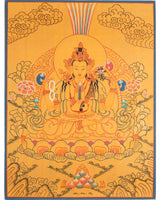
Bodhisattva Avalokiteshvara Chengrezig | Tibetan Buddhist Thangka

100% AUTHENTIC

HANDMADE

FREE SHIPPING
Bodhisattva Avalokiteshvara Chengrezig
Introduction To The Thangka :
This Avalokiteshvara (Chenrezig or Guanyin) Thangka is an original, hand painted in Nepal in the Tibetan Buddhist tradition. This vintage thangka depicts the Bodhisattva Avalokiteshvara who embodies the compassion of all the Buddhas. Here he is depicted as the Four-Armed Avalokiteshvara, also called Shadakshari, holding lotus, crystal prayer beads (mala), and the mudra of prayer posture at his heart.
How to take care of your thangka?
-Hang your thangka in a traditional silk brocade
-Regular Inspection of your thangka; examine the borders and all attachments.
-Keep thangkas covered when they are on display but not in use.
-Rotate thangkas between display and storage on a regular basis, two to four times a year, to reduce the amount of exposure to light. Keep away from sunlight and humidity.
-Do not apply liquids or other materials to the surface of the thangka.
----------------------------------------------------------------------
Size: 9"/ 23 cm (width) x 12"/ 30 cm (height)
Materials: Cotton Canvas, Acrylic Colors, Genuine 24K Gold
-----------------------------------------------------------------------
THIS THANGKA IS HAND-PAINTED IN THE TRADITIONAL STYLE AND THE QUALITY IS HIGH
--------------------------------------------------------------------------
How does Thangka benefit us?
The Thangka is revered as a holy item. They promote positivity, spread Buddhism's teachings, bring about peace, harmony, and oneness, and dispel any negative energy that may be there. There are numerous uses for thangka, not just by core practitioners, but also by others for positive vibration, meditation, and prayers. The Thangka swiftly transforms into a meditational tool for anyone who wants to contemplate Buddha's life and existence since it depicts Buddha's physical manifestations and distinctive characteristics. Even a glance of the Thangka can instantly reflect its sacredness.If you enjoy performing rituals and prayers, Thangka would be a tremendous help. You can offer prayers, conduct rituals, and read mantras loudly in reference to the respective deity shown on the Thangka.
Shipping & Returns
We ship worldwide. Orders dispatch in 2–3 business days. International delivery typically arrives in 4–10 business days via DHL Express, depending on destination and carrier conditions. All items ship free globally.
Returns are accepted within 14 days of delivery. Products must be returned in original condition for a refund to be issued once received and inspected. Terms and conditions apply.











